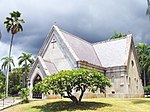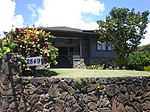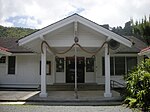Temple Emanu-El (Honolulu)
Honolulu stubsJewish organizations established in 1938Reform synagogues in HawaiiReligious buildings and structures in HonoluluSynagogues completed in 1960 ... and 2 more
Synagogues in HawaiiUnited States synagogue stubs

Temple Emanu-El is a Reform Jewish congregation in Honolulu that was established in 1938, and joined the Union for Reform Judaism in 1952. The synagogue building at 2550 Pali Highway was consecrated in 1960 under the spiritual leadership of Rabbi Roy A. Rosenberg. The architect was Edward Sullam, and the builder was T. Takahashi. The sanctuary is decorated with 12 8-foot paintings by the New Mexico-based artist Alice Flitter.
Excerpt from the Wikipedia article Temple Emanu-El (Honolulu) (License: CC BY-SA 3.0, Authors, Images).Temple Emanu-El (Honolulu)
Pali Highway, Honolulu Nuuanu
Geographical coordinates (GPS) Address Nearby Places Show on map
Geographical coordinates (GPS)
| Latitude | Longitude |
|---|---|
| N 21.330555555556 ° | E -157.84444444444 ° |
Address
Pali Highway
Pali Highway
96817 Honolulu, Nuuanu
Hawaii, United States
Open on Google Maps









